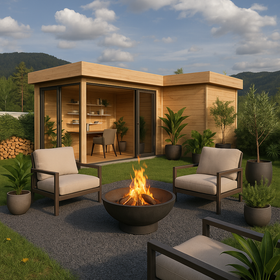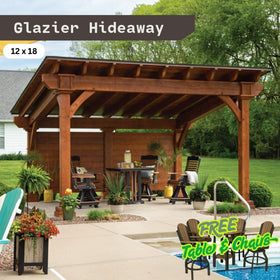512-777-0154

How a Garden Room Supports Mind & Body Health
A garden room might look like a simple building tucked between the lawn and a few topiary plants. But it’s far more than a place to store tools or hide clutter. Think of it as a private retreat in your own backyard. A detached space that blends practicality with peace.
For some, it becomes a quiet spot for remote work. For others, it’s a corner for relaxation, a small gym, or even a studio where creativity can flow without interruption. The difference is in how it supports both mind and body. A few steps across the grass can separate you from noise, demand, and the constant pull of home life.
With the right lighting, fresh air, and natural views, a garden room can sharpen attention and ease tired eyes. It can also help with stress management by giving you permission to pause, reflect, or simply be patient with yourself.
A leaf outside the window can do more for balance than another screen inside the house.
Benefits of a Garden Room to Mental and Physical Health
A garden room isn’t just about adding square footage. It changes the way you move through your day. Mentally and physically. It gives you space to pause, stretch, think, and reset. Away from laundry piles. Away from noise. Away from screens.
And the benefits? You’ll feel them fast. Let’s get into what this small space can really do.
1. A break for your brain (less stress, more calm)
When every room in your house has a role, it can get loud. Not always in sound, but in mental load. One second, you're working. The next, you're half-thinking about dinner, half-scrolling, half-listening to background chaos. It adds up. Your brain feels like it’s juggling flaming furniture.
A garden room fixes that. With physical boundaries comes mental space. The act of stepping into a separate structure helps lower cortisol, the stress hormone that loves to overstay its welcome.
Quiet spaces, lower sound levels, and no distractions allow your nervous system to breathe.
Soundproofing your Sawmill Structures Harvest Grand Bungalow 107 Garden Room adds an extra layer. So does furniture that’s there for one purpose only: to rest, work, or recharge. Even just sitting in a calm space with soft lighting and no pings or dings can help reset your mental state. You don’t need to practice anything complicated. Just sit. Let your mind settle.
2. Natural light and greenery boost your mood
Your brain doesn’t love dark corners or flickering overhead lights. It prefers sunlight. Real sunlight. The kind that floods a space through large windows and wakes up your serotonin. Natural light tells your body it’s time to function. That it’s safe and it’s daytime.
In a GardenHouse24 USA Miriam 44A Classic Garden Room, daylight does most of the work for you. It sets your rhythm. Keeps your mood balanced. Helps you feel less stuck in artificial environments.
Greenery adds more than just a nice view. Whether it’s a wall of vines, an aviary outside your window, or just some well-placed pruning around the path, nature has a calming effect.
Being close to trees, leaves, and sunlight boosts happiness. Improves your quality of life. Lowers anxiety. These elements work together to create a subtle atmosphere that shifts how you feel in the space.
As a result, fewer anxious thoughts, a lighter mood, and a better shot at staying present.
3. Movement made easier
Most people don’t exercise because their house doesn’t exactly invite them to. The couch is right there. The floor space is tight. The distractions are endless.
GardenHouse24 USA Q Bic ALU 44A Garden Room removes that friction. Even walking to it gets you moving. It’s just far enough from the kitchen to count.
Set up a yoga mat. Maybe a few light weights. Keep it simple. This isn’t a gym. It’s a private space that encourages regular movement. A few stretches before work. A walk out there during lunch. Five minutes of yoga when your brain won’t focus.
Because the space is separate, it doesn’t compete with your other habits. You’re not trying to squeeze a workout between the couch and the coffee table.
You’re giving yourself a dedicated space to move your body without pressure. That shift matters. It makes the practice more consistent. And more likely to stick.
4. Space for creativity and hobbies
Your brain likes routines. But it also needs outlets. Somewhere, it can switch off from being useful and start being curious.
Sawmill Structures Eze Breeze Sunroom Cabin can be that outlet. A space for painting. Writing. Playing an instrument. Even something as small as rearranging furniture or planting outside the windows can wake up new parts of your brain.
Creative time helps regulate mental health. It reduces stress. Improves focus. And brings a sense of calm that’s hard to get when you’re constantly switching tasks inside your main house.
The key is separation. If your paint supplies live on the kitchen table, your creative session has to be fast, clean, and convenient. In a garden room, the mess can stay put. So can your attention.
Hobbies are often the first thing to go when time gets tight. But when the space exists, it makes it easier to protect them.
5. Sharper focus and healthier routines
If you work from home, you know how blurry the line can get between job and life. One minute you're answering emails. Next, you're wiping down the counter. Your brain never really switches off or on.
GardenHouse24 USA Q Bic ALU 70G Garden Room adds that needed edge. Step outside, close the door, and your brain knows it's time to work. Or rest. Or do whatever task the space is built for.
That environmental cue does a lot of heavy lifting. It helps build stronger routines. Creates a sense of structure. And improves productivity without the burnout. When you’re done, walking back into the house becomes your transition back into personal time.
That small routine has big mental health benefits. You’re more likely to get better sleep. Less likely to carry stress into your evening. And you’ll probably find your attention span getting a bit stronger.
The room doesn’t have to be complex. It just needs to be yours. And separate enough to help you start and stop your day with intention.
Tips to Get the Most Out of Your Garden House
- Let in the daylight. Place your desk, yoga mat, or meditation spot where natural light hits. Add soft lamps when sunlight fades to keep the atmosphere gentle on the eyes.
- Give each corner a role. Dedicate one side for yoga, stretching, or meditation. Keep another for work, painting, or reading. Defined spaces help your brain switch gears with less effort.
- Add natural touches. Bring in plants, wood accents, or hang art that reflects nature. Even pruning the view outside can shift the feeling of the room. Natural elements create balance and steady your mental state.
- Make movement easy. Keep small equipment like a mat, weights, or resistance bands in sight. The walk across the garden is movement in itself. Build on it with short practices.
- Cut down the noise. Use soundproofing, curtains, or rugs to absorb sound. Quiet transforms the space into a true sanctuary for recovery and rest.
- Make it yours. Choose indoor furniture that feels good to use. Add details on the wall that spark happiness or calm. The more personal the space feels, the more consistent your time there will be.
Why You Probably Need Some Breathing Room
Modern life doesn’t exactly leave space to breathe. Screens glow all day. Notifications pile up. Every corner of the house carries some demand. It’s no wonder mental health feels stretched thin.
A garden room offers a pause. Wood walls. Natural light. A quiet sanctuary that separates you from the constant noise. It doesn’t need to be extravagant. It just needs to be yours. A place where meditation feels possible. Where your feeling of calm returns without effort.
Think of it as a balance tool. A space that steadies your mental state. Whether you use it for work, yoga, or just sitting still, the effect is the same. More focus. Less stress. Better rhythms for your day.
That’s why our outdoor freedom rooms for garden houses exist. Not as luxury add-ons, but as practical spaces designed to support health, clarity, and routine.
The real question is simple. If you had your own breathing space, how would you use it?









